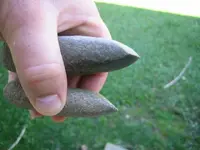You are using an out of date browser. It may not display this or other websites correctly.
You should upgrade or use an alternative browser.
You should upgrade or use an alternative browser.
Please explain Celt vs. Adze
- Thread starter Shemanese
- Start date
Lets see.... 1. Celts were hafted to a handle. Not so much tied on, but inserted into a socket in the handle. Adzes, are similar, but hafted with the beveled side facing up. In other words, how they would best work for cutting tasks.
As far as size, well, I've found celts that were only two and a half inches long.
The blades on celts are ground evenly, where as the blade on an adze is gonna be beveled on one side and flat on the other.
Hope this helps
As far as size, well, I've found celts that were only two and a half inches long.
The blades on celts are ground evenly, where as the blade on an adze is gonna be beveled on one side and flat on the other.
Hope this helps
Bent-Twig
Sr. Member
Hey ,
Here is a visual of what Jonny is talking about on the working end(bit) . The piece in the top of the photo is a celt and the one on the bottom is the adze. See how the celt is sharpend evenly from both sides and the adze is sharpend mainly from one side. Hope this helps.
Happy Huntin' ,Bent-Twig.
Here is a visual of what Jonny is talking about on the working end(bit) . The piece in the top of the photo is a celt and the one on the bottom is the adze. See how the celt is sharpend evenly from both sides and the adze is sharpend mainly from one side. Hope this helps.
Happy Huntin' ,Bent-Twig.
Attachments
- #5
Thread Owner
Thanks guys for the responses and pics. More questions?? lol
Why the difference in the sharpening? Does one cut better than the other? Uneven wear turns a celt into an adze? But it seems they are two different forms. Is the adze more of a hand-held tool? Were adze's first? Are both a woodworking tool? Were they used as a hide scraper? Sorry for the million questions...
Stone tools are interesting. I believe many tools are unrecoginized because they aren't pretty. My .02..
Why the difference in the sharpening? Does one cut better than the other? Uneven wear turns a celt into an adze? But it seems they are two different forms. Is the adze more of a hand-held tool? Were adze's first? Are both a woodworking tool? Were they used as a hide scraper? Sorry for the million questions...
Stone tools are interesting. I believe many tools are unrecoginized because they aren't pretty. My .02..
WhiteCountyPaleo
Hero Member
- Joined
- Jul 21, 2008
- Messages
- 546
- Reaction score
- 76
- Golden Thread
- 0
- Location
- Lafayette, IN
- Detector(s) used
- AT PRO
The bit and handle looks like the number 7. When
using an adz, the chips come off the bottom edge
and the chips create a channel.
using an adz, the chips come off the bottom edge
and the chips create a channel.
- #7
Thread Owner
OK, thanks guys, Seems an adze can be used both with the edge flat with the sharpening on the underside, (kind of like a plane) and also with the edge down and the sharpening up. With the edge down and a hammerstone used, I can see where it could be an effective scraper,or channeler. (I like that description) Digging out a channel of wood, or burnt wood, would be a perfect task for that tool. Depending on what was scraped, or dug, the edge need not be really sharp. There was probably a tool for that purpose too. Not all adze's were made out of flint, or granite, or a really hard stone. Most were, but sandstone could be used on softer material, and would be easier to sharpen.
Similar threads
- Replies
- 3
- Views
- 441
- Suggestion
- Replies
- 1
- Views
- 337
- Replies
- 9
- Views
- 2K
Users who are viewing this thread
Total: 1 (members: 0, guests: 1)





